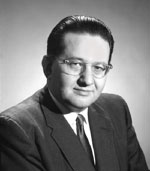| AJG biography |
 Andrew J. Galambos was born in Budapest, Hungary on
June 27, 1924. His father, Joseph B. Galambos, had served in the Hungarian army in World War
I, and understood the futility of that war. He also understood that the war had resolved
nothing, and that its outcome made the occurrence of a second world war inevitable. So, in
anticipation of the outbreak of World War II, Joseph Galambos moved his family to the United
States in 1926 in the hope that they could avoid the coming war. Andrew J. Galambos was born in Budapest, Hungary on
June 27, 1924. His father, Joseph B. Galambos, had served in the Hungarian army in World War
I, and understood the futility of that war. He also understood that the war had resolved
nothing, and that its outcome made the occurrence of a second world war inevitable. So, in
anticipation of the outbreak of World War II, Joseph Galambos moved his family to the United
States in 1926 in the hope that they could avoid the coming war.Andrew lived with his family in New York City throughout his childhood and into young adulthood. He demonstrated a proficiency in science and mathematics early in his education. He entered an undergraduate degree program in physics at City College of New York, which was interrupted by the United States’ entry into World War II. Galambos was convinced that Hitler’s Germany was a threat to civilization itself, and in 1942 (much to the dismay of his father), he enlisted in the U.S. Army in response to his own conviction that Nazism must not triumph. His experience in that war engendered the thinking that later culminated in his successful analysis of the causes of war in general, and how to prevent its recurrence. After the war, Galambos resumed his formal education, earning degrees in physics from City College of New York and the University of Minnesota. He taught physics at New York University, Brooklyn College, Stevens Institute of Technology, the University of Minnesota, and Carleton College before he entered the aerospace industry to work in astrophysics and astronautics. In 1952 Galambos moved to Los Angeles, California to accept a position at North American Aviation, and later at Ramo-Wooldridge Corporation, the forerunner of TRW Space Technology Laboratories. His principal interest was in astronautics, following his lifetime dream of furthering mankind’s expansion into space. Although he nominally was hired as an astrophysicist, he did important work as a rocket scientist, developing the mathematics for rocket thrust optimization ("throttle-back") that is still used today. To his dismay, he learned that his own work was being used in weapons development (the Atlas ICBM), and not for the exploration of space, as he originally intended. He became disaffected by the rampant theft and misuse of intellectual property in the state-funded aerospace boondoggle, and in 1960 he left the industry to accept a position on the physics faculty at Whittier College. His experience at Whittier College was formative. Galambos frequently found himself in debates with faculty members in the departments of economics and political science (the latter being a field, he realized, whose name is oxymoronic). He came to understand that the empty promises of politicians not only do not solve the problems they purport to fix, but in fact often achieve effects that are precisely the opposite of what they originally intended. He sought a different approach. In 1961, Galambos founded his own school, The Free Enterprise Institute (FEI)—a private teaching and research institution through which he could address perpetually recurrent societal problems by developing and promoting solutions that are more effective than the success-proof methods of political statism. His motivation carried a special sense of urgency. As a physicist whose own work had been abused he well understood the fact that the human species’ command of physical science and its derivative technologies has accelerated far beyond our development of social technologies that enable us to use our scientific progress responsibly. As Galambos observes in Course V-50: "We now have the physical science, technological
capability at our disposal to wipe out every human being on this planet. This is not for
the future; we’ve got this now, and each year's further technological advance makes
it easier. We do not have a corresponding knowledge in what is, at this time, called
"social science"—we do not have an adequate grasp of this subject to cope with
it so that we can create a social structure that is capable of preventing such a
catastrophe, and making it possible for the technological advances to be channeled into
constructive channels exclusively, and not ever into destructive channels. We are not
playing with spears anymore; we've got hydrogen bombs, and there will be worse
things yet."
Galambos uniquely applied the scientific method in creating non-coercive solutions to problems in human interaction through advanced technologies that protect all forms of property—especially intellectual property, which has the highest potential for beneficent effects when used constructively, and the highest potential for harmful effects when used destructively. In the volitional science courses he developed and promulgated through FEI (especially V-50 and V-201), he shows how the use of such technologies are essential to the creation of a durable structure for civilization. Galambos continued to develop and integrate important concepts for human progress, and taught those concepts in his lecture courses until he ceased presenting live lectures due to deteriorating health in 1987. His courses are now once again being made available by the trustees of his natural estate, who are continuing his important work. |
